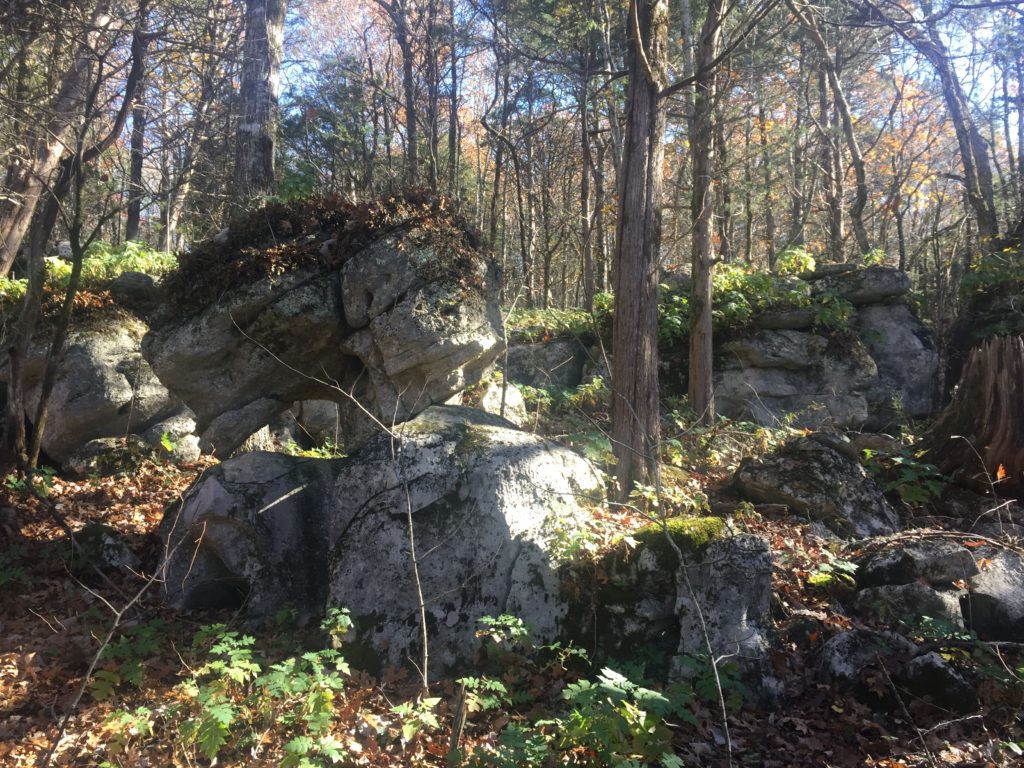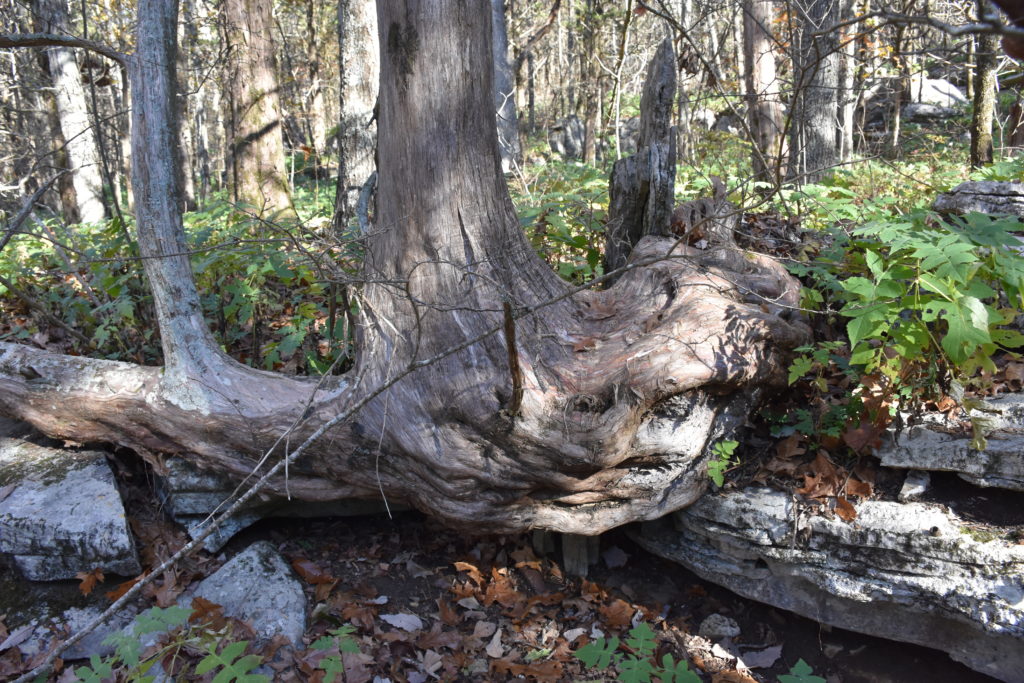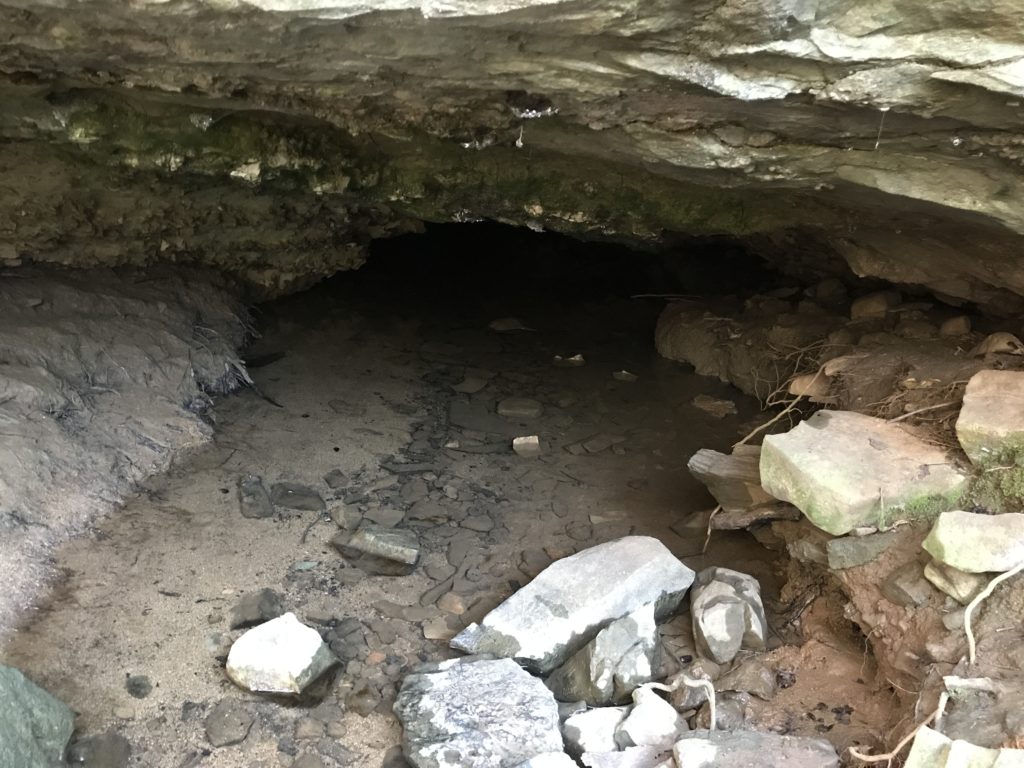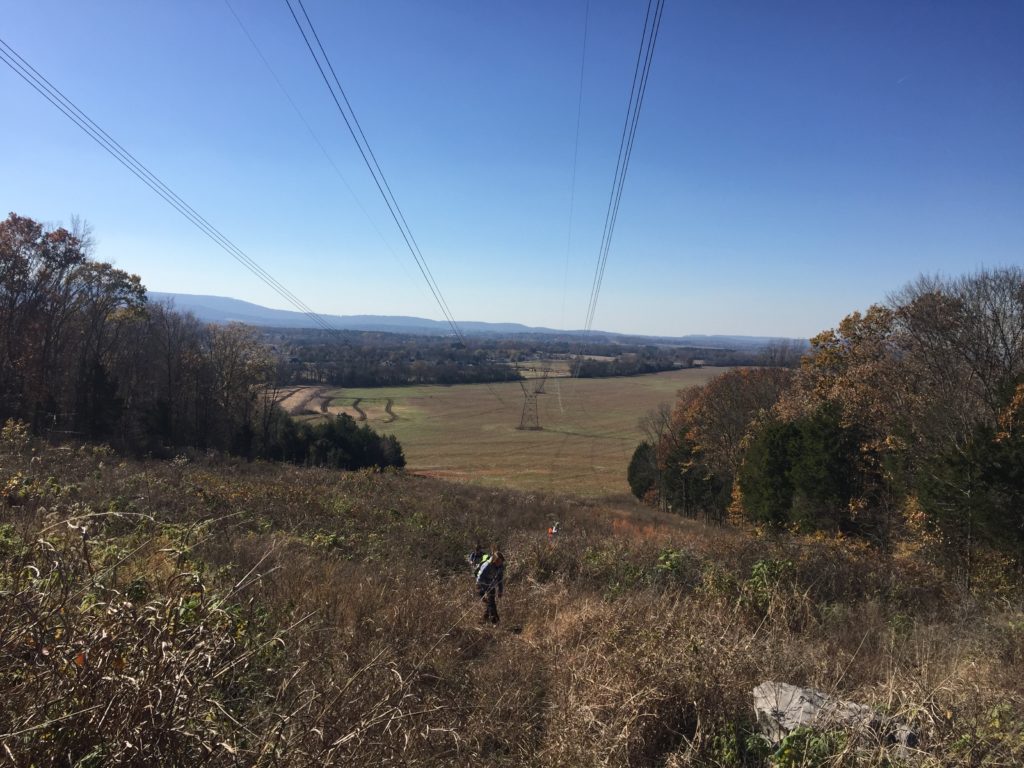Berry Mountain – Limestone, Family Lore, and Valley Views

At least once each year, Land Trust staff takes a break from our normal routine for a staff hike. We explore a property together that most of the team may have never seen before and in the process enjoy a reminder of why our work is important. Last week, our staff hike for 2017 took us to one of our conservation properties located on Berry Mountain northeast of Huntsville.

Land Trust Staff at Berry Spring (left to right): Katey Deasy, Financial Administrator; Andy Prewett, Land Manager; Melanie Manson, Marketing Director; Brandon Perry, Land Steward; Marie Bostick, Executive Director; Hallie Porter, Development Director; Lori Pence, Land Steward.
A conservation property is land that we monitor and maintain to ensure that unique or important natural features are protected but it is not open to the public. There are several reasons that a property may not be available for public access (a topic we plan to share more about in an upcoming blog post) but in this case it is land locked. We do not own lands around it that would allow visitors access without crossing private property. However, we do hope to offer Land Trust Member Only hikes in the future.
The Berry Mountain Property has some interesting natural and historic features that we enjoyed and wanted to share with you.
Limestone and Groundwater Recharge
Characteristic for North Alabama, Berry Mountain is primarily made of porous limestone and has some impressive karst features – including caves and sinkholes. Not far from the beginning of our hike, we entered an area dense with limestone boulders. As we walked, limestone covered more and more of the ground until it became an uninterrupted moonscape pitted with holes and channels. This area serves as an ideal groundwater recharge area. Spaces like this one are valuable resources for underground aquifers. As rainwater falls onto the limestone, it is funneled directly down through the holes in the rock and into groundwater below rather than flowing on top of the surface through a creek or stream. When areas like this one are disturbed by human activities including paving, development, or logging, it can create increased runoff and reduce natural recharge of groundwater.

Credit: International Association of Hydrogeologists (IAH) Commission on Karst Hydrogeology (Goldscheider & Drew 2007)
The limestone field was covered in short green plants called Hairy Leafcup, which pops up this time of year but will die back as the temperatures warm again. As we climbed down the mountain the limestone tapered off again but we stumbled upon a few interesting formations, including one that we all tried to identify.

Suggestions included a dog (maybe a schnauzer?) or a lion but a few agreed it looked like the extraterrestrial creature from the movie Alien. Ugh! Scary. I prefer to stick with the puppy. What do you see?

Plantlife
We saw lots of beautiful cedars and oaks that have grown undisturbed since the land was last logged around the turn of the century. Several were growing through and around the limestone.

Cedar growing from and around limestone.
A land study conducted by the Land Trust of North Alabama when the property was acquired showed that red cedar and Muhlenberg’s oak were the dominant species but there is a diverse variety of plant life present despite dry soil conditions due to the limestone drainage described above. We also spotted a few large shag bark hickory trees and two trees that had grown together to look like one.
History of the Property
A little over 100 acres of the property was donated to Land Trust of North Alabama by Watts Properties Partnership in 1999 followed by a gift of the remaining 18.85 acres from the Berry Family in 2007, making the total Land Trust property around 120 acres.
At the lowest point of the property, there is a wet-weather spring, which seems to have served as the hub of the property for those who lived there or nearby.

Berry Spring – pool at the mouth of the spring
Berry Family oral histories suggest that the site was the home to Native Americans. Lynne Berry Vallely, who donated a portion of the property, tells us “‘The Indians’ were said to live around the spring or get their water from the spring when my Berry ancestors bought the property in the late 1800s…[the Berry Family] built a two room house there at the spring and lived in it until about 1920.”
In the 20’s as Lynne mentions, the family relocated the two room structure across the road from the original home site and expanded. The house still stands in that location just a short distance away from its original spot. The foundation of the original two room home, made of limestone blocks approximately 4-5 feet long and over a foot wide, remains just downhill from the spring.

Remnants of the home site foundation
Lynne says “My dad had a watering trough for his cattle made out of limestone blocks [at the spring].” Part of this limestone trough, used until the farm was dedicated exclusively to row crops in the 1950’s, along with a few other remnants from the home site can be found in the area surrounding the spring.
When we visited the area, the spring was mostly dry since we haven’t had any significant rainfall recently. However, there was some water trickling from the mouth of the spring, which flows from an opening in the limestone hillside. Land Trust observations indicate that this spring is home to salamanders and perhaps a cave dwelling species of crawfish.
Valley Views

As we headed back up the mountain to our starting point, we crossed a power line cut and looked back down the mountain to see an impressive view of the valley below and south towards Wade Mountain and Monte Sano Mountain.
Although we pride ourselves on making beautiful spaces available for everyone to enjoy, our ultimate goal is to make the best choices for the land. For now, that means leaving this space primarily untouched. We’ll continue to share more about the unique spaces protected by the Land Trust of North Alabama, even the ones you can’t stop by for a visit.
Sources:
- International Association of Hydrogeologists (IAH) Commission on Karst Hydrogeology
- Wikipedia.org – Groundwater Recharge
- Natural Resources Conservation Service – USDA
- National Park Service